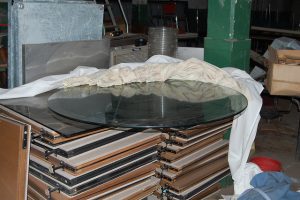Glass painting is easier than it looks
If you’ve ever painted your living or working space, you know that getting professional results can be a challenge. You want a professional, finished look, but no matter how careful you are, you never seem to get the desired results. The good news is that glass painting is easy to do and delivers a beautiful finish. Even better, glass painting doesn’t require special tools or training.
Professional results from glass painting
Working with glass surfaces is incredibly easy. It’s also a very forgiving surface when it comes to cleaning up drips and imperfections. Here are four expert tips to ensure that you get the right result every time.
Prepare your surface! The biggest mistake people make when painting (anything) occurs even before they apply a single drop of paint. Good surface preparation ensures that you have a good result. Porous surfaces require a lot of surface preparation. Small holes, scratches, chips and other mishaps will all show through the paint. Glass doesn’t have any of these issues, but you still need to do proper surface prep. Clean the glass surface with alcohol and steel wool to remove any dust, dirt, adhesive or anything else that might have dried on the glass surface. Working with a perfectly clean surface will yield the best finish.
Work slowly! There’s no point in racing through a painting project. Working slowly ensures that you get smooth, even coverage across your entire surface. One mistake people often make when the painting is skimping on the number of coats they apply. If you’ve ever painted a surface and later thought that the paint “dried to a different color,” it’s probably because you didn’t apply enough coats of paint. Generally, a single coat of paint won’t offer enough coverage, regardless of the surface you’re working on.
Let the paint dry! This goes along with Tip #2. Allow each coat of paint to dry fully before you add another coat. A paint can be dry to the touch in a few minutes, but only the surface paint molecules are dry. Let the paint sit for 2-4 hours after applying another coat. This allows the solvents below the surface to evaporate properly. It also makes the paint more durable.
Don’t wait to clean up your mistakes! Clean up excess paint, spills and drips sooner rather than later. Cleaning up wet paint is much easier than cleaning up dry paint, so keep a wet sponge or cloth handy to wipe out your drips. If you have to remove dry glass paint for any reason, you can use a single-edged razor blade to get the paint off the glass surface, up to a point. Glassprimer™ glass paint alters the surface of the glass. Once the paint cures completely, you won’t be able to remove it at all. If you spot an imperfection, smudge, drip, etc., move quickly to clean up your mistake!
Photo Credit: EnKayTee, via Flickr.com






